

Greenhouse gases. Greenhouse gases Global warming is recognized by almost all atmospheric scientists as a significant environmental problem caused by an increase in levels of certain trace gases in the atmosphere since the beginning of the Industrial Revolution in the mid-18th century.
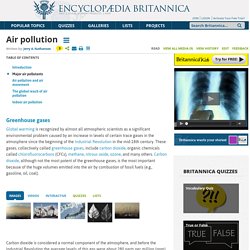
Movement of Air. Air Pollution Starts a Movement. Kevin Hall grew up on a farm outside Firebaugh, in the heart of the San Joaquin Valley.
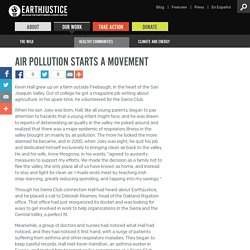
Out of college he got a magazine job writing about agriculture. In his spare time, he volunteered for the Sierra Club. When his son Joey was born, Hall, like all young parents, began to pay attention to hazards that a young infant might face, and he was drawn to reports of deteriorating air quality in the valley. He poked around and realized that there was a major epidemic of respiratory illness in the valley brought on mainly by air pollution. The more he looked the more alarmed he became, and in 2000, when Joey was eight, he quit his job and dedicated himself exclusively to bringing clean air back to the valley. Through his Sierra Club connection Hall had heard about Earthjustice, and he placed a call to Deborah Reames, head of the Oakland litigation office. Hamilton set out to build a bridge between the medical community and the Sierra Club and other activists concerned with air quality.
Progressive Movement - water, effects, environmental, United States, chemicals, toxic, use, health. Environmental Movement - water, effects, disasters, pollutants, United States, history, causes, impact, chemicals, industrial, toxic, world, human, power, disposal, use, life, health, oil. History is marked by movements that challenge the dominant political ideology in ways that cannot go unnoticed.
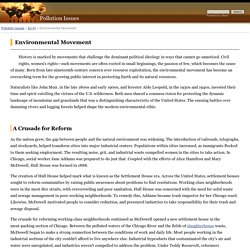
Civil rights, women's rights—such movements are often rooted in small beginnings, the passion of few, which becomes the cause of many. Born from late-nineteenth-century concern over resource exploitation, the environmental movement has become an overarching term for the growing public interest in protecting Earth and its natural resources. Naturalists like John Muir, in the late 1800s and early 1900s, and forester Aldo Leopold, in the 1930s and 1940s, invested their time and spirit extolling the virtues of the U.S. wilderness. Both men shared a common vision for protecting the dynamic landscape of mountains and grasslands that was a distinguishing characteristic of the United States. The ensuing battles over damming rivers and logging forests helped shape the modern environmental ethic.
A Crusade for Reform (© Bettmann/Corbis. Like Addams were drawn to the Progressive Party. Water and Air Pollution - Facts & Summary - HISTORY.com. In the latter part of the 13th century, in an effort to reduce air pollution, England’s King Edward I threatened Londoners with harsh penalties if they didn’t stop burning sea-coal.
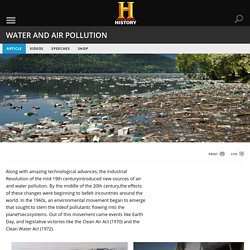
However, the king’s regulations–and those of subsequent leaders–had little effect. By the late 18th century and first part of the 19th century, coal came into large-scale use during the Industrial Revolution. The resulting smog and soot had serious health impacts on the residents of growing urban centers. In 1952, pollutants from factories and home fireplaces mixed with air condensation killed at least 4,000 people in London over the course of several days. The Carbon Cycle - Climatica. Carbon is critical to sustain a huge range of Earth’s functions.
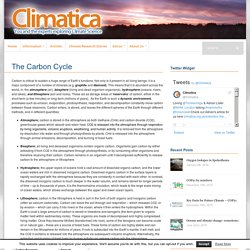
Not only is it present in all living beings, it is a major component of a number of minerals (e.g. graphite and diamond). Body. Introduction to the Research Problem You are to consider how much of a city's built environment is claimed by machine space (space which is set aside exclusively for the care and use of machines).

Much of an urban area's built environment is, for example, devoted almost exclusively to use by automobiles, buses, and trucks. Streets, parking lots, driveways, and loading ramps occupy well over half of all surface area in some parts of the city. But other machines and equipment occupy -- and dominate -- other space as well. HAZARDS AND RESPONSES. HAZARDS AND RESPONSESWhat is a hazard?
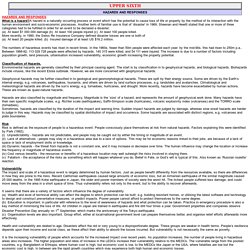
A hazard is a naturally occurring process or event which has the potential to cause loss of life or property by the method of its interaction with the human environment and socio-economic processes. Another term of familiar use is that of ‘disaster’ in 1969, Sheenan and Hewitt stated that one or more of three categories had to be fulfilled in order for an event to be declared a disaster;(a) At least $1 000 000 damage (b) At least 100 people injured (c) At least 100 people killed.More recently, in 1990, the Swiss Re Insurance Company defined disaster losses are one or both of(a) At least 20 people killed. (b) Insured damage of at least US $16.2 million. The numbers of hazardous events has risen in recent times. In the 1960s, fewer than 50m people were affected each year; by the mid-90s, this had risen to 250m p.a..
Classification of Hazards.Environmental hazards are generally classified by their principal causing agent.